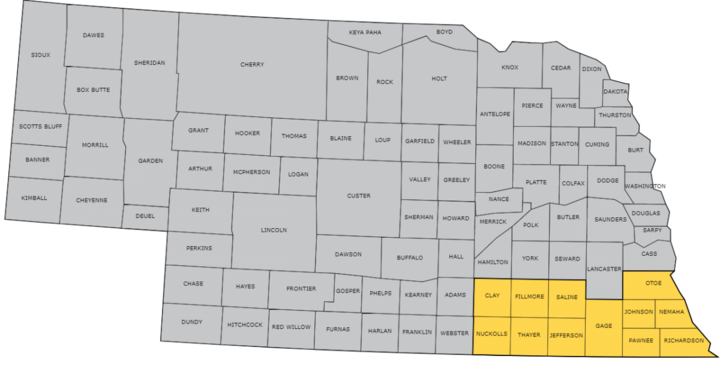Interest and concern about micronutrient needs of soybean is common among farmers and agronomists in southeast Nebraska (Figure 1) due to higher yields than in previous decades and the increased availability of micronutrient fertilizers in both liquid and dry formulations. Nine micronutrients are needed in small amounts by soybeans. Micronutrients include boron (B), chlorine (Cl), cobalt (Co) copper (Cu), iron (Fe), manganese (Mn), molybdenum (Mo), nickel (Ni), and zinc (Zn). We bring to you an extended series of CropWatch articles on micronutrient fertility and plant nutrition for soybean production in southeast Nebraska (Figure 1). We discussed boron in the last CropWatch issue, so if you missed it, we encourage you to go back and read it: Soybean Micronutrient Management in Southeast Nebraska: Boron. If you have taken the quick 2-question survey, share with us what micronutrients you are most concerned about on your farm for soybeans.
Take the Micronutrient Survey
Did you know that chlorine (Cl) is the element you see in the periodic table, but it only exists as chloride (Cl-), an anion or negatively charged form, in soil and taken up by plants. Therefore, from here forward in the article, we will use chloride when talking about chlorine the element.
Soybean Chloride Deficiencies and Toxicities in Southeast Nebraska
In soybeans, chloride is needed for osmotic regulation in plant cells and is mobile from old to new tissue. Deficiency symptoms are infrequent because soybeans are one of the least sensitive crops we grow. Deficiency symptoms are not clearly described but may include chlorosis and wilting of leaves in soybeans. Toxicity symptoms include leaf tip scorching, premature yellowing or bronzing of leaves, and leaf loss.
The University of Nebraska-Lincoln Extension has not observed chloride deficiency in soybeans to date. Chloride deficiencies are not a concern in soybeans but could occur in winter wheat, sorghum or corn. Of most concern in southeast Nebraska is chloride deficiency in winter wheat based on soil sample results and research done in adjacent areas of Kansas. However, toxicity is more of a risk in soybeans in southeast Nebraska given the high concentration of chloride in some groundwater used for irrigation.
Soil Chloride Availability to Soybeans
Chloride is a monovalent anion (Cl-) found in soil solution, unique among other micronutrients. Chloride is weakly held in soil and can be leached with high rainfall and irrigation. Each year, availability in the soil is regulated by inputs including chloride in the rain, irrigation water, fertilizers like potash (potassium chloride), crop residue/organic matter and salts found in saline soil.
Soil and Plant Tissue Testing
Soil sampling and interpretations for chloride in the top two feet are used for other crops more sensitive to deficiency like winter wheat. Since toxicity is more commonly a problem in soybeans, researchers have found that soybean plant tissue nutrient analysis can be used to determine potential chloride toxicity problems. Soybean chloride sufficiency is best determined during full bloom to early pod set, typically in early July. The uppermost fully expanded trifoliolate without the petiole from 30 random plants should be sent to the lab in a paper bag. Learn more about how to conduct soybean plant tissue sampling by watching a video created by Nathan Mueller a few years ago. The chloride sufficiency range is 200 to 1400 ppm or 0.02 to 0.14 percent. Soybean varieties are categorized by seed companies in areas where chloride toxicity is an issue as chloride “includers” or “excluders”. Research in Arkansas found that concentrations high enough to cause a 5% yield reduction was 1885 ppm for chloride excluders and 3923 ppm for includers at the R3 growth stage (beginning pod). The addition of large amounts of chloride would more likely cause yield losses in chloride includers. Companies have not rated most varieties in the Midwest since chloride toxicity is not normally a problem.
Chloride Fertilizer Suggestions and Management
The need to apply chloride fertilizer to soybeans in southeast Nebraska is extremely low based on our current knowledge. Kansas State University documented yield response to chloride fertilization in winter wheat but not soybeans (Ruiz Diaz, 2019). Similarly, research done at Iowa State University found no yield increase with chloride fertilization in soybeans, just corn.
Fertilizer recommendation:
- If applying potash and other chloride-containing fertilizers, apply them before corn, grain sorghum or winter wheat.

Groundwater irrigated soybean may be receiving significant amounts of chloride in areas of southeast Nebraska. Read a recent CropWatch article and view the maps of nutrient contributions by county: Crediting Essential Nutrients Applied in Irrigation Water. We have seen some hotspots for groundwater chloride including two wells in Saline County that indicated 140 and 180 lbs of chloride would be applied with 6-inches of applied groundwater. If you are still concerned about chloride, we encourage you to conduct your own on-farm research through the UNL On-Farm Research Network by contacting us.
Water sampling recommendations:
- Test irrigation water next summer for chloride and other macro and micronutrients to know what is being applied per inch
- Use soil moisture sensors and other irrigation scheduling practices to reduce the chance of overwatering soybeans with high chloride irrigation water
Other resources
- Micronutrients for Soybean Production in the North Central Region
- Symptoms Identification Key for Nutrient Deficiencies in Soybeans
- Nutrient Management for Agronomic Crops in Nebraska (pages 43-50 and 118-119)
- NebGuide: Micronutrient Management in Nebraska
- Nebraska Soybean and Corn Pocket Field Guide – 2019 Edition – (pages 263-269) Visit extension offices in Saline, Nemaha, Jefferson, Gage or Clay counties for a free hard copy
